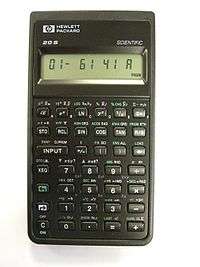HP-20S
The HP-20S (F1890A) is an algebraic programmable, member of Pioneer series of HP calculators produced from 1988 to 2003. It is similar to HP-21S. It has 99 program lines of fully merged program and ten memory registers.

HP 20S
Libraries
There are six libraries in the ROM, which could be loaded to RAM and used and edited as user programs.
- A- [ROOT] finder, finds a root of f(x)=0
- B- [INT] integral, calculates definite integral using Simpson method
- C- [CPL] complex numbers manipulations
- D- [3 by 3] matrix manipulations and line equations solver
- E- [qUAD] quadratic equation solver
- F- [fit] curve fitting, using exponential, logarithmic and power functions
Design peculiarities
The HP-20S is not a clean design. It shares the quirks with its close relative, HP-21S. Some of them are:
- INPUT and SWAP keys, which are awkward and not clear solution to mimic RPN functionality.
- Absence of "x<y" test, which enforces using two tests with additional labels and GOTOs in programs which need this functionality.
- A real bug is "x<=y" test. First of all, its name is misleading. Really, it is "x>=y" test in terms of RPN calculators. The manual says that x is 'hidden' while y is 'visible'. But yx power key on the calculator's keyboards functions in the traditional fashion of other HP RPN calculators. The second problem here is due to algebraic design: in order to separate two arguments of a test should the user divide them either with arithmetic operation or INPUT. If using arithmetic, like:
- RCL 6
- +
- RCL 7
- x<=y?
- GTO A
- the display shows the "pend" indicator, since calculator sees a pending addition operator. After the program stops, the user can press "=" sign and get the result of pending operation. If the user uses INPUT instead of arithmetic operation, the calculator will display the ":" indicator. In order to hide this effect, the user should place "C" clear command somewhere before program end.
Nevertheless, HP-20S is a functional and fast calculator, with very good LCD, keyboard, look, and feel. It uses the normal infix notation rather than RPN, which most HP scientific calculators use.
gollark: But nobody is actually forced to work anywhere else, that would be unethical.
gollark: If one country sells 10 million employment, their unemployment goes up by 10 million and whoever buys it has a 10 million reduction in unemployment.
gollark: This wouldn't involve anyone actually working anywhere else...
gollark: Just sell "employment", in a totally abstract sense.
gollark: No, I don't mean sell actual *people*.
External links
- https://www.manualslib.com/manual/768754/Hp-Hp-20s.html?page=113#manual User Manual
- http://www.voidware.com/calcs/hp20s.htm
- HP-20S on MyCalcDB (database about 1970s and 1980s pocket calculators)
- http://www.hpmuseum.org/software/20stvm.htm Financial TVM calculations
- http://www.hpmuseum.org/software/20sbool.htm Boolean functions (AND, OR, XOR, NOT)
- http://www.rskey.org/detail.asp?manufacturer=Hewlett-Packard&model=HP-20S Gamma function
This article is issued from Wikipedia. The text is licensed under Creative Commons - Attribution - Sharealike. Additional terms may apply for the media files.